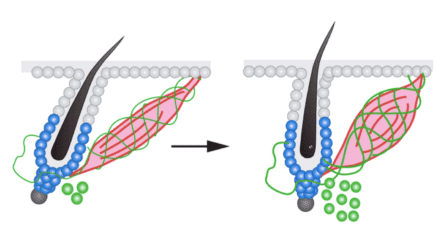Why Do We Get Goosebumps? The Answer Lies with the Stem Cells that Grow Hair.
NewsThe Context: While scientists suspect that goosebumps help animals with fur stay warm in cold environments, the reason that humans get goosebumps has been unclear.
The Study: Goosebumps activate a stem cell population in the hair follicle that stimulates hair regeneration, finds a new study in mice by NYSCF – Robertson Stem Cell Investigator Ya-Chieh Hsu, PhD, of Harvard University and published in Cell.
The Importance: The work illuminates the biological purpose of goosebumps and furthers our understanding of how stem cells change their activity in response to the external environment. These discoveries can also be leveraged to understand tumor formation and wound healing.
For animals with fur, goosebumps make sense: standing hair on end traps air to create a layer of insulation, keeping them warm in chilly conditions. We humans, however, don’t have a coat of thick fur, so why do we still get goosebumps? According to a Cell study by NYSCF – Robertson Stem Cell Investigator Ya-Chieh Hsu, PhD, of Harvard University, the answer has to do with activating stem cells that regenerate hair, and the results shed light on how changes in stem cells can be linked to environmental cues.
“We have always been interested in understanding how stem cell behaviors are regulated by external stimuli. The skin is a fascinating system: it has multiple stem cells surrounded by diverse cell types, and is located at the interface between our body and the outside world. Therefore, its stem cells could potentially respond to a diverse array of stimuli — from the niche, the whole body, or even the outside environment,” said Dr. Hsu, the Alvin and Esta Star Associate Professor of Stem Cell and Regenerative Biology, who led the study in collaboration with Professor Sung-Jan Lin of National Taiwan University, in a press release.
“In this study, we identify an interesting dual-component niche that not only regulates the stem cells under steady state, but also modulates stem cell behaviors according to temperature changes outside.”
The Anatomy of Goosebumps
The cell types that lead to goosebumps also play a role in regulating hair regeneration. Specifically, the sympathetic nerve (which helps the body maintain homeostasis, or a ‘steady state,’ and responds to external stimuli) connects to a muscle in a layer of the skin called the mesenchyme. This muscle then connects to hair follicle stem cells, which regenerate hair and help heal wounds. When it senses cold, the sympathetic nerve sends a signal to the muscle to contract, causing our hairs to stand on end.

Dr. Hsu’s team discovered that not only does the sympathetic nerve connect to muscle, but it also connects directly to hair follicle stem cells, wrapping around them like a ribbon — providing an unexpected association between the nervous system and hair follicle stem cells.
“We could really see at an ultrastructure level how the nerve and the stem cell interact. Neurons tend to regulate excitable cells, like other neurons or muscle with synapses. But we were surprised to find that they form similar synapse-like structures with an epithelial stem cell, which is not a very typical target for neurons,” said Dr. Hsu.
Goosebumps Allow Prolonged Cold to Trigger Hair Regeneration
Usually, the sympathetic nervous system (our ‘fight or flight’ regulator) is constantly active at a low level, which helps maintain steady hair regeneration. Dr. Hsu’s team found that in prolonged cold, however, the sympathetic nerve activates at higher levels, causing hair follicle stem cells to jump into action and grow hair at a faster pace.
“It’s a two-layer response: goosebumps are a quick way to provide some sort of relief in the short term. But when the cold lasts, this becomes a nice mechanism for the stem cells to know it’s maybe time to regenerate a new hair coat,” explained Yulia Shwartz, PhD, a postdoctoral fellow in Dr. Hsu’s lab.
According to Dr. Hsu, the muscle is structurally important for ensuring the whole system functions. When the scientists removed the muscle, the nerve retracted and the connection was lost. It’s a two-component system: the nerve sends the signal and the muscle helps that signal reach the stem cells.
Beyond Goosebumps
Not only does this study identify how and why humans get goosebumps, it shows how stem cell activity can be influenced by the surrounding environment, which is important for understanding healthy skin function as well as how cells respond to adverse conditions like wounds or tumor formation.
“We live in a constantly changing environment,” said Dr. Hsu. “Since the skin is always in contact with the outside world, it gives us a chance to study what mechanisms stem cells in our body use to integrate tissue production with changing demands, which is essential for organisms to thrive in this dynamic world.”
Journal Article:
Cell Types Promoting Goosebumps Form a Niche to Regulate Hair Follicle Stem Cells
Yulia Shwartz, Meryem Gonzalez-Celeiro, Chih-Lung Chen, H. Amalia Pasolli, Shu-Hsien Sheu, Sabrina Mai-Yi Fan, Farnaz Shamsi, Steven Assaad, Edrick Tai-Yu Lin, Bing Zhang, Pai-Chi Tsai, Megan He, Yu-Hua Tseng, Sung-Jan Lin, Ya-Chieh Hsu. Cell. 2020. https://doi.org/10.1016/j.cell.2020.06.031
Photo credit: Jon Chase/Harvard Staff Photographer

